2024년 10월 5일 토 맑음
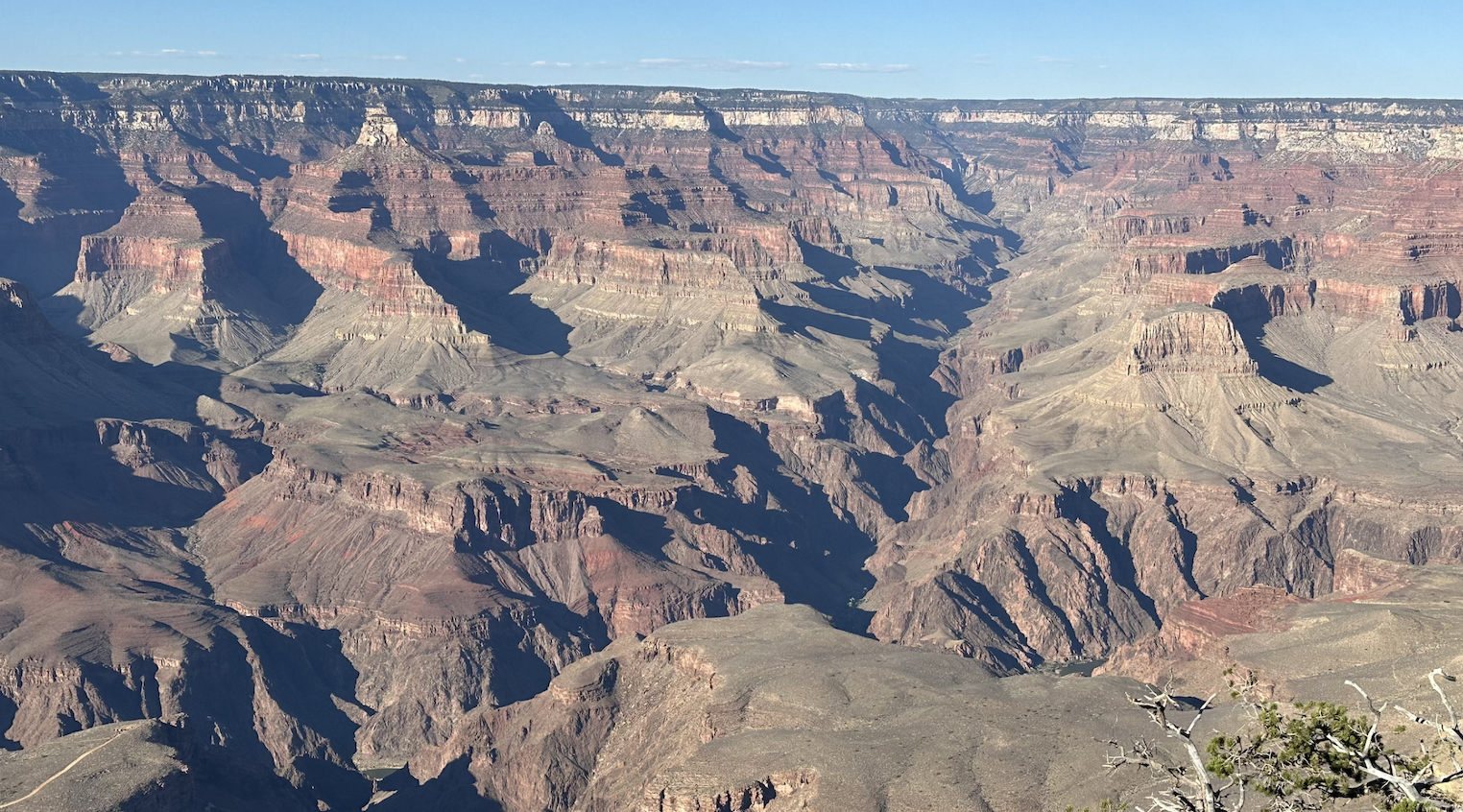
Grand Canyon 으로 향한다. 매년 와서 봐도 새롭게 느껴지는 거대한 지형. 지질학자들의 Mecca 인 Grand Canyon. 이번에는 Yavapai Geology Museum (지질학 박물관)에 전시된 설명을 모두 읽어보고 싶다. 그리고, “ Grand Cayon Trail of Time” 왕복 5.6 마일을 걷고 싶다. Grand Canyon 을 보러 오는 분들을 위해 박물관에 전시된 지형 설명을 모두 사진으로 찍어 올려 보았다.

HW 58,40,15 를 80마일 (128Km/h)로 달려본다. 엄청덥다. 화씨 109도 (섭씨 43도). 올때는 더위를 피하기위해 밤새도록 13시간 동안 달려왔다. 총 거리 1503 miles (2414Km). 이 거리라면, 서울에서 북경까지 육로로 1300 Km이니깐 거의 북경 왕복거리라고 보면된다.

Grand Canyon에 도착해보니 90도 정도로 그렇게 덥지 않았다. 그동안 California는 Indian Summer 로 엄청 더웠는데 Arizona는 예외인 듯했다.

가뭄과 산불에 강하다는 Ponderosa 소나무 숲으로 이루어져 있는 Kaibab 고원을 지나 드디어 South Rim에 도착한다. 눈앞에 전개되는 저 장엄한 Grand Canyon! 숨이 막혀온다. 저 엄청난 계곡이 어쩌면 이렇게도 조용할 수 있을까? 마치 저 밑에 흐르는 Colorado 강물 소리만 들리는 것같다.

와! 저 미약한 Colorado강이 이렇게 엄청난 지형을 만들었다. 보이지 않는 힘이란 바로 이런 것이다. 깊이 1.6km, 폭 16km, 길이 443Km의 Grand Canyon은 지질학의 보고가 아닐수 없다.

형형색색의 지층들이 떡시루처럼 겹겹이 쌓여있는 모습이 몽블랑에서 본 알프스 산맥의 휘어진 습곡과는 많이 달랐다. 저 밑 계곡에서 Rim까지 올라 오는데 지질학 역사로 무려 20억년이 걸린다. 지금 나는 한눈에 20억년의 억겁을 그대로 보고있는 것이다. 여기 말고 다른 어느곳에서 연속되는 지질학적으로 의미가 있는 암석들을 한꺼번에 볼수있을까?

지금 나는 South Rim의 2억 5천만년전의 중생대 트라이아이스기 암석을 밟고, 20억년전의 원생대 계곡 바닥에서는 콜로라도강이 선캄브리아기의 편암을 깍아내고있는 것을 보고있는 셈이다. 위 사진에서 보듯이 측면 협곡이 두드러지는데, 이는 콜로라도 강과 지류가 층을 깎아내어 시간이 지남에 따라 협곡의 넓이가 넓어졌기 때문이다. 하바수 캐년(Havasu Canyon)과 브라이트 엔젤 캐년(Bright Angel Canyon)과 같은 일부 눈에 띄는 측면 협곡은 뚜렷한 지질학적 특징을 보여주고있다.
The Colorado River races 1,400 miles from its headwaters in the Rocky Mountains to its end at the Gulf of California. Twenty percent of its course (277 miles) winds through Grand Canyon. 콜로라도 강은 로키산맥의 원류에서 캘리포니아 만 끝까지 1,400마일이나 뻗어 있다. 코스의 20%(277마일)가 그랜드 캐년을 통과한다.

What Caused the Rise of the Colorado Plateau?
선캄브리아대부터 신생대까지 융기와 침강을 반복하며 얕은 바다와 늪지로 이루어진 곳이었기 때문에 퇴적층이 두껍게 발달했다. 이지대는 신생대 당시 로키 산맥과 함께 3000미터 이상 솟아올라 현재의 콜로라도 고원이 형성된 것이다. 지난 600만 년 동안 콜로라도 강과 그 지류의 침식력에 의해 Grand Canyon 이 형성되었지만, 초기 형성은 콜로라도 고원이 융기된 약 7천만 년 전에 시작되었다. 차등 침식은 Grand Canyon의 독특한 모습을 형성하는 데 중요한 역할을 했다. 침식에 대한 암석층의 다양한 저항은 협곡 전체에 뚜렷한 계단, 절벽, 테라스를 만들었다. 가장 깊고 오래된 암석층은 비슈누 지하 암석으로 약 17억년에서 20억년 전에 형성된 변성암과 화성암의 복잡한 집합체를 구성한다.

지구의 나이 48억년. 그 일부인 20억년을 Grand Canyon 에서 느낄수 있었다. 1700만년전 태평양 판이 북아메리카 판을 들어 올리면서 Colorado 고원이 융기했다. 바로 이 시점이 Grand Canyon 의 시작이다. 마치 타임머신을 타고 과거로 돌아가는 기분이다. Grand Canyon 곳곳의 퇴적암에는 선캄브리아기에서 신생대까지, 고대 동·식물들의 화석이 풍부하게 남아 있다. 일반적으로 지반이 융기하면 그 과정에서 암석이 부서지고 변형되는데 특이하게도 콜로라도 고원은 그대로 땅을 들어 올린 것처럼 변형이 거의 없었다. 퇴적층 줄무늬가 기울어지거나 끊겨 있지 않고 수평을 이루고 있는 이유다. 지질학적 역사를 시간순으로 볼 수 있는 교과서인 것이다.

This is a relief map of the Grand Canyon. The elevation is represented using shading. The lightest color represents the highest elevation while the darkest color represents the lowest elevation.
그런데 Grand Canyon 북쪽에서 흘러내리는 Glen Canyon 계곡물은 콜로라도 강이 아닌 리오그란데 강의 지류였다. 현재는 Glen Canyon 에서 강이 흘러와 서쪽으로 90도 꺾여 Grand Canyon으로 흘러들지만, 과거에는 Grand Canyon 동부를 남북으로 흐르는 강이었던 것이다. 이후 로키 산맥이 더 융기하며 남쪽에서 막힌 강줄기가 거대한 호수를 이루었고, 별도로 Colorado 고원 서쪽으로 흘러가던 강줄기(현재의 Meed lake 부근)는 고원을 점차 침식해들어가며 계곡 자체가 동진, 보다 깊은 계곡을 만들고 마침내 고원 동부의 강과 연결되어 버렸다.

View of the Grand Canyon from Space
그 결과 Colorado 강은 카리브 해가 아닌 태평양을 향해 흐르게 되고, 빠른 유속과 풍부한 유량으로 차별침식이 강화되어 현재의 Grand Canyon이 만들어진 것이다. Grand Canyon을 자세히 보면 이런 차별침식의 흔적이 나타나는데 남쪽 벽은 거의 깎아지른 절벽이지만 북쪽 사면은 약간 넓은 모양이다. 콜로라도 고원 전체가 수평으로 솟아오른 게 아니라 융기 과정에서 다소 삐딱하게 솟아오른 탓에 북쪽 사면이 더 넓게 깎여나간 것이다.



 헝가리 Walk along the Danube in Budapest 08/16-20/2024
헝가리 Walk along the Danube in Budapest 08/16-20/2024
 Minaret Lake & Devils Postpile in Sierra Nevada 09/21/2024
Minaret Lake & Devils Postpile in Sierra Nevada 09/21/2024

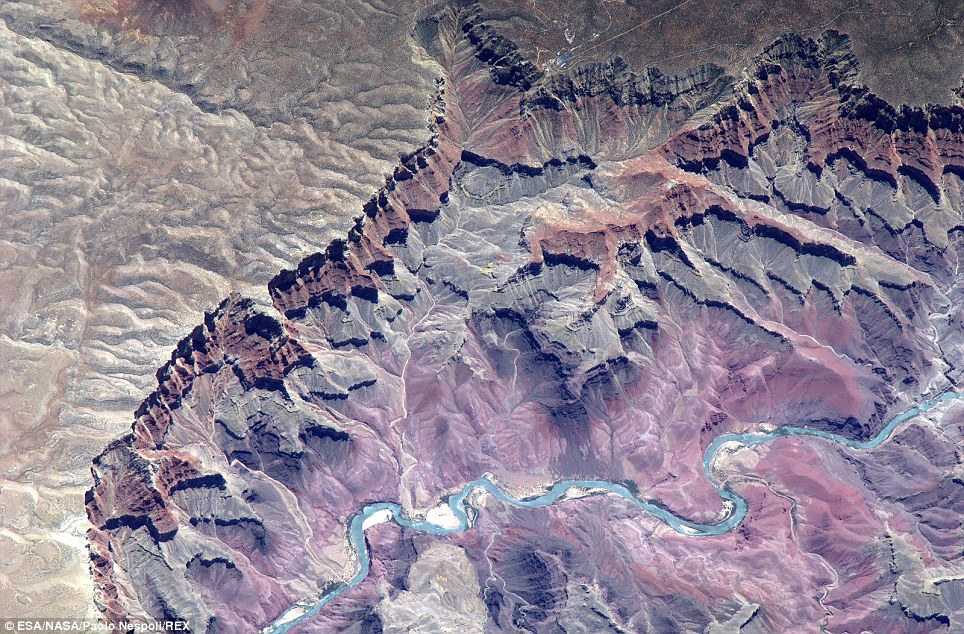
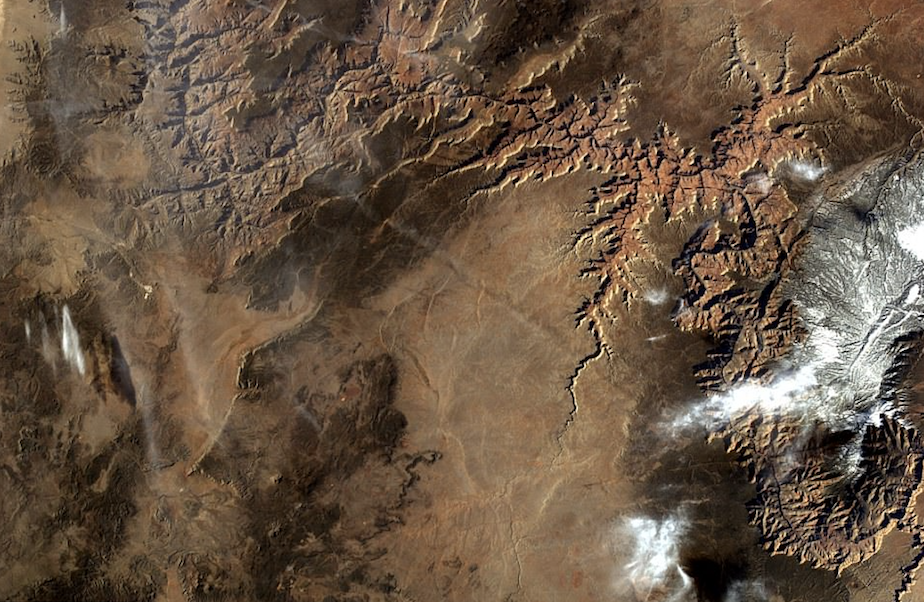


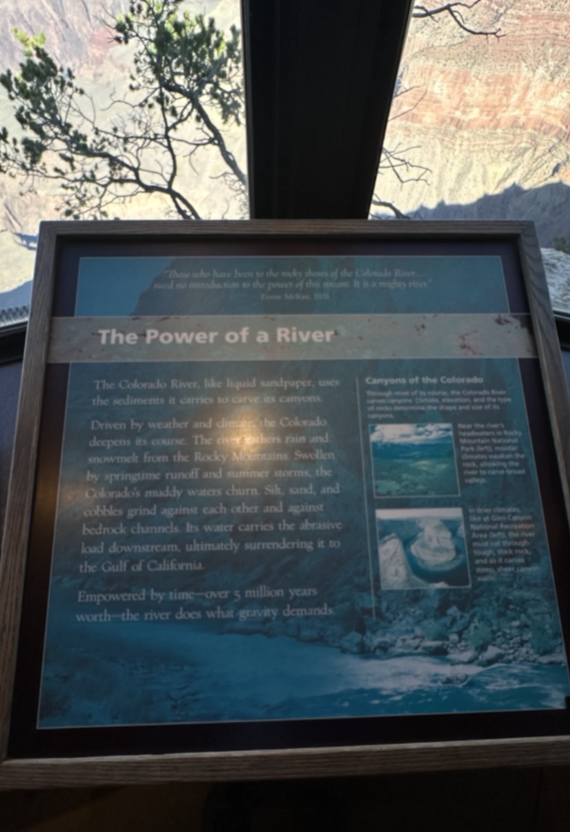

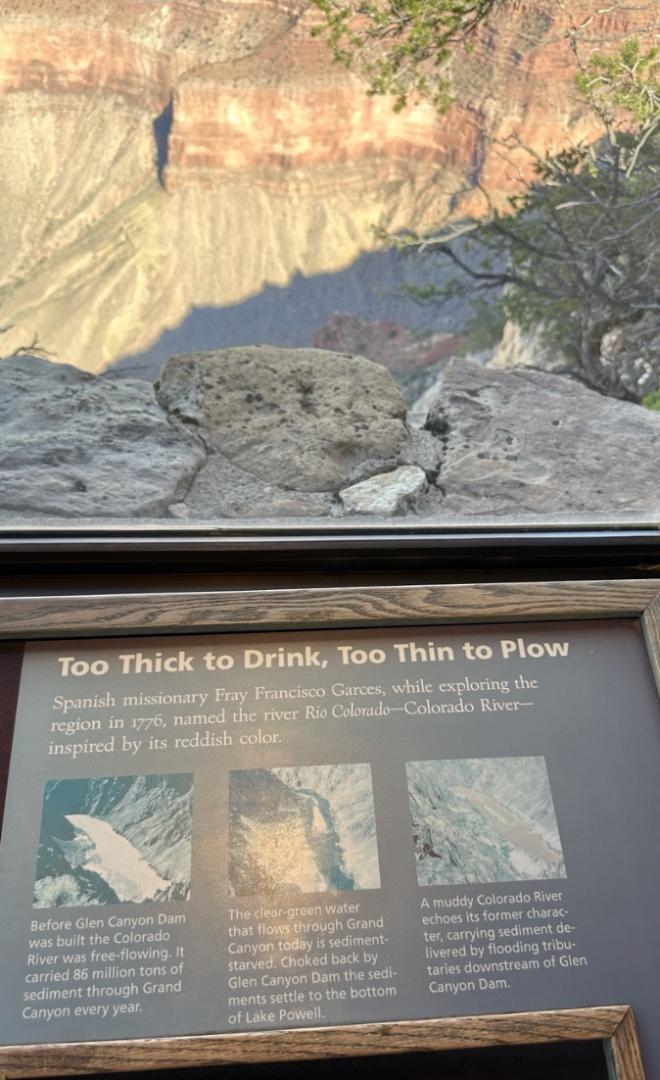








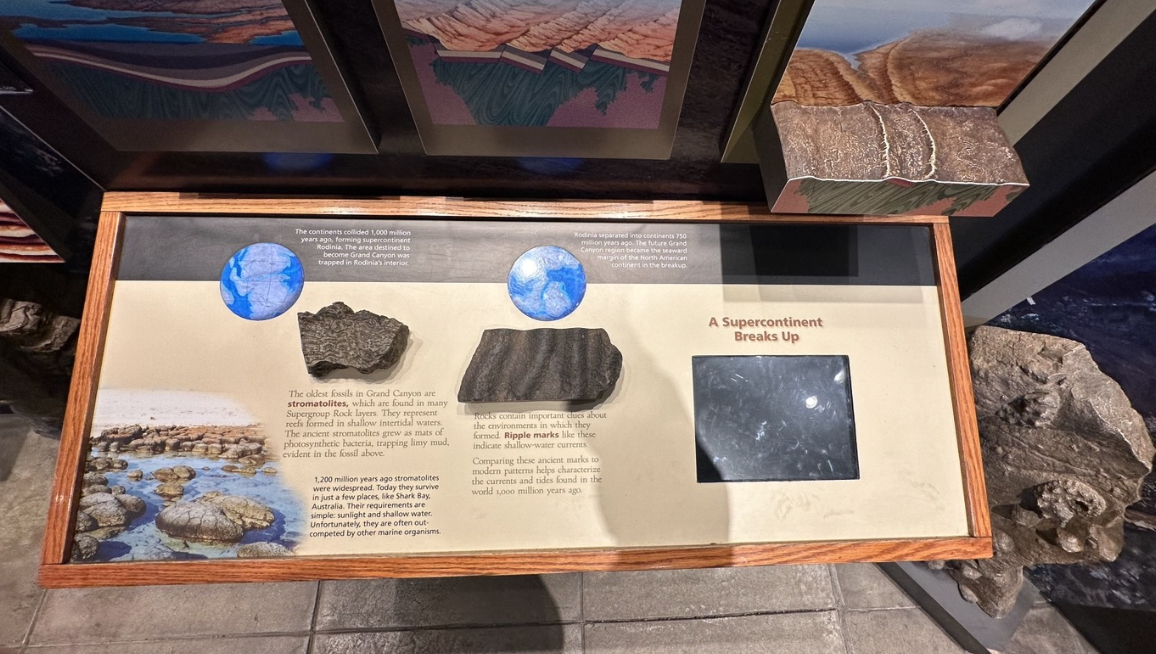



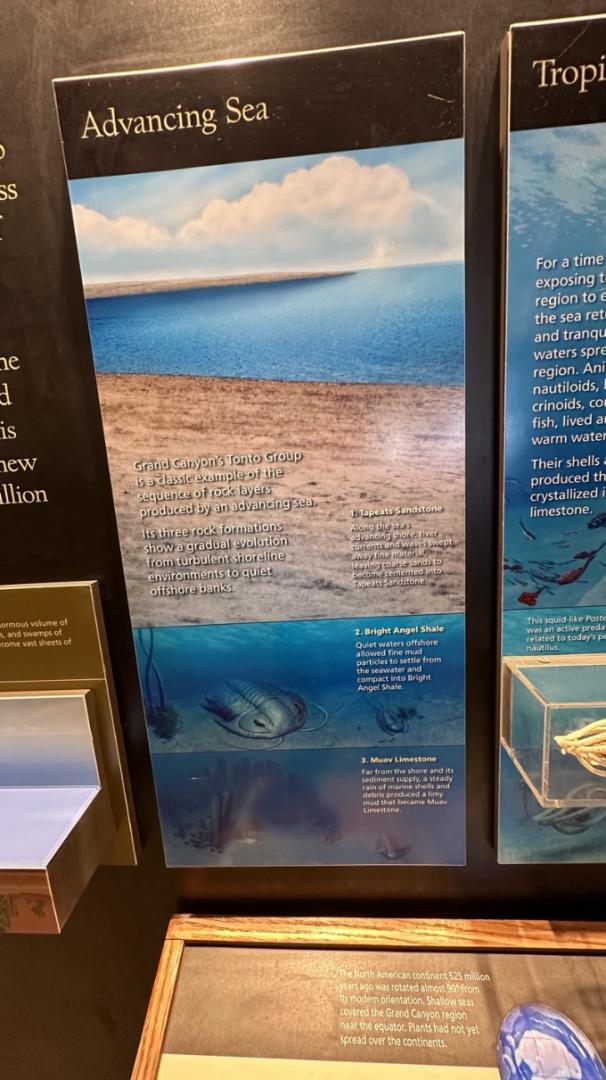


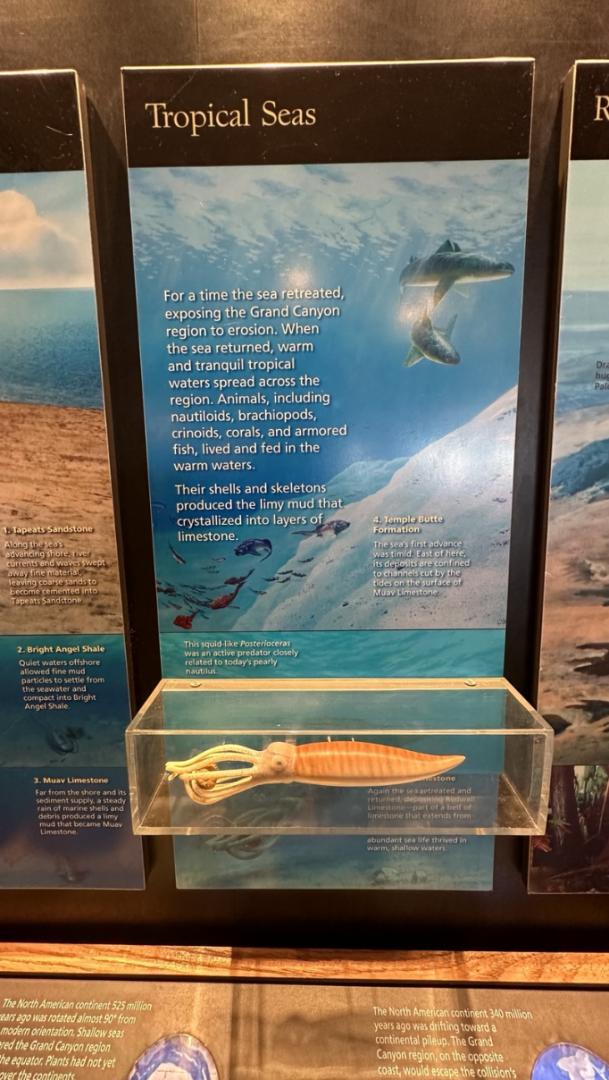


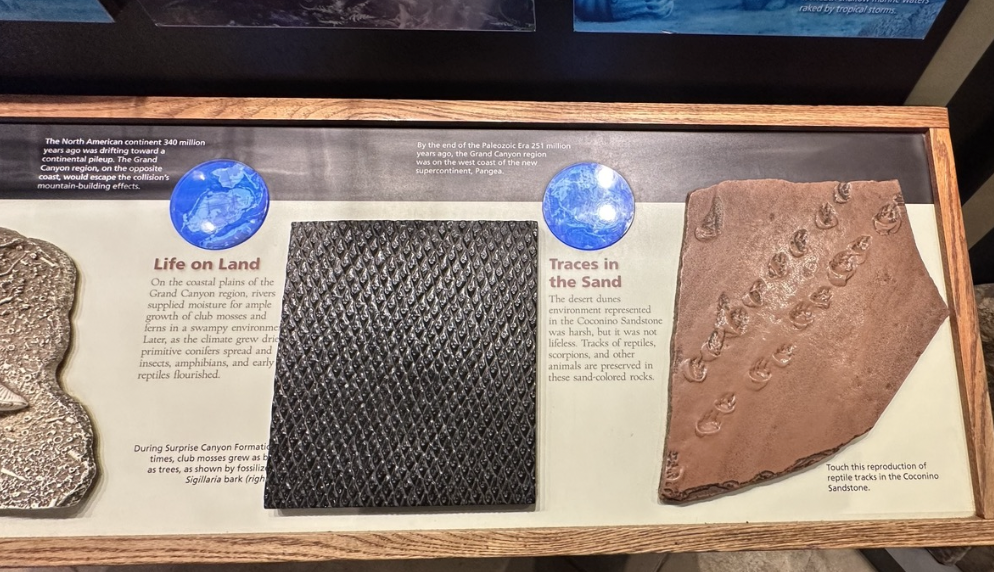

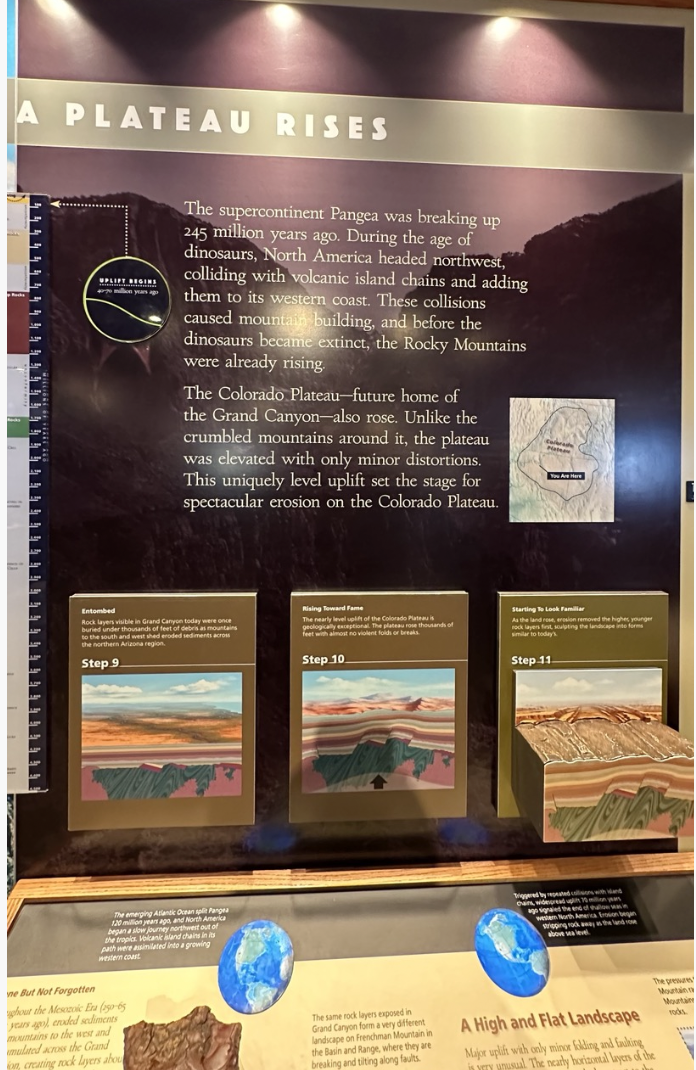






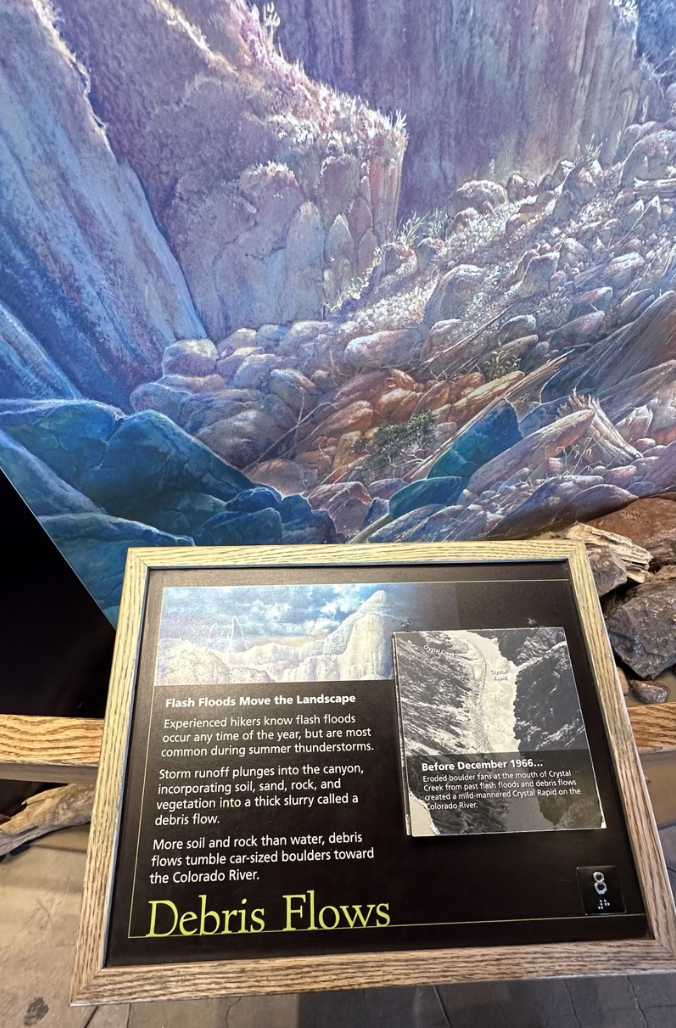


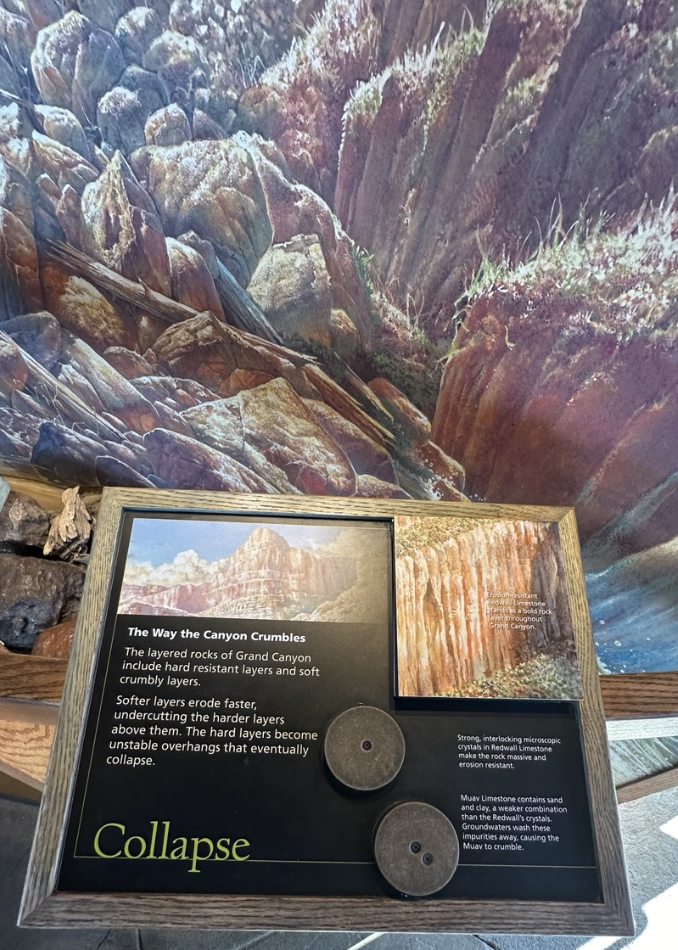

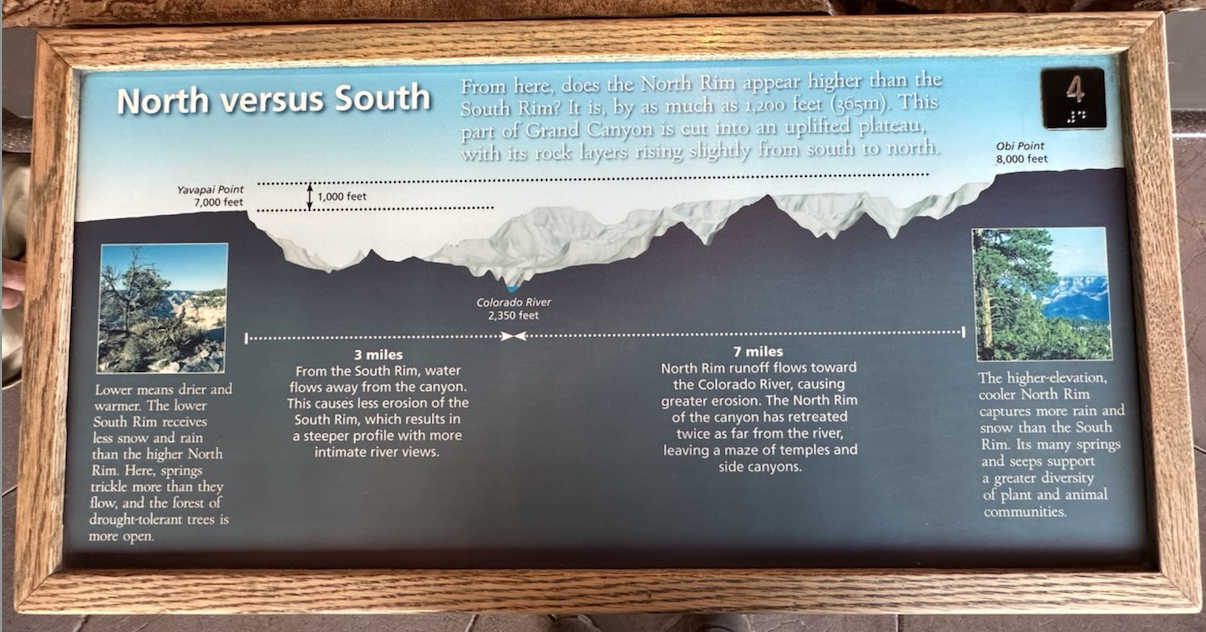

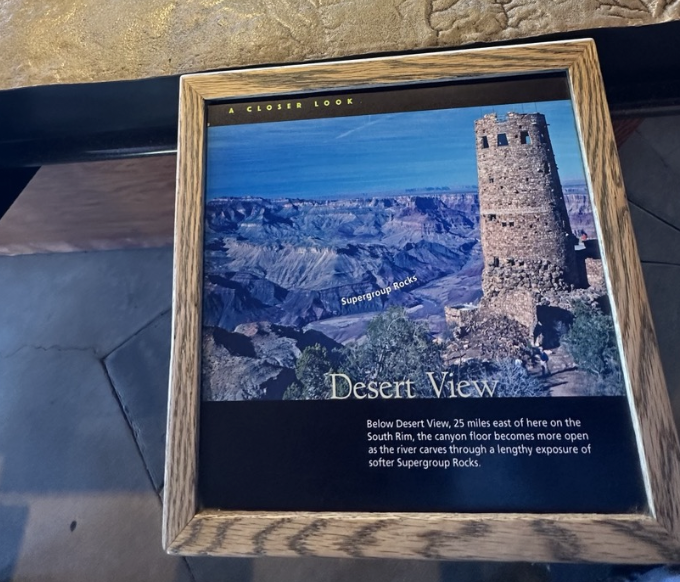
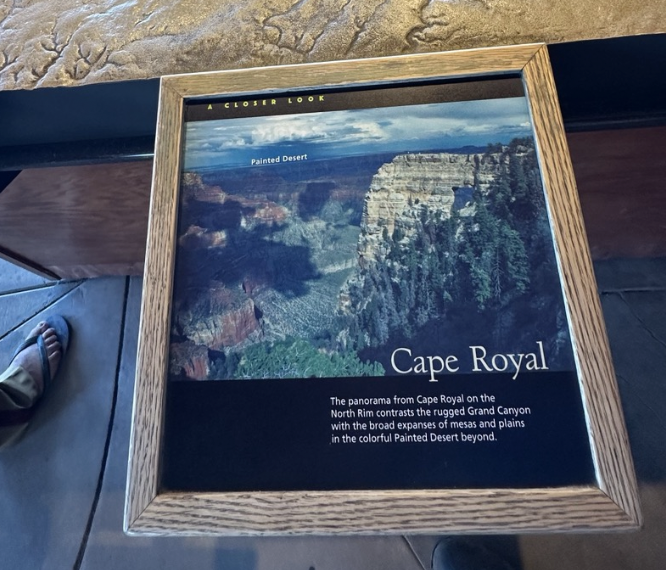

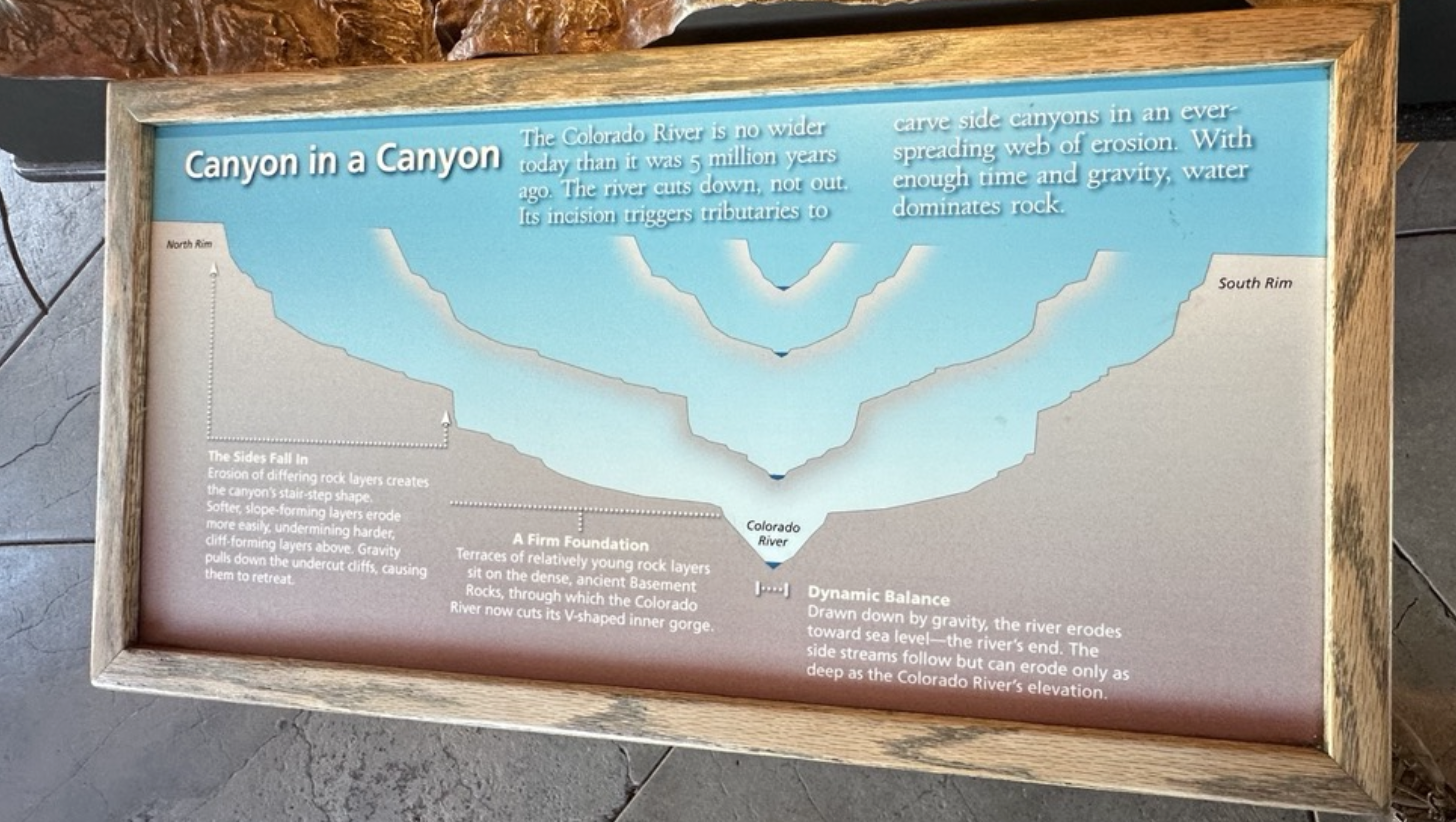

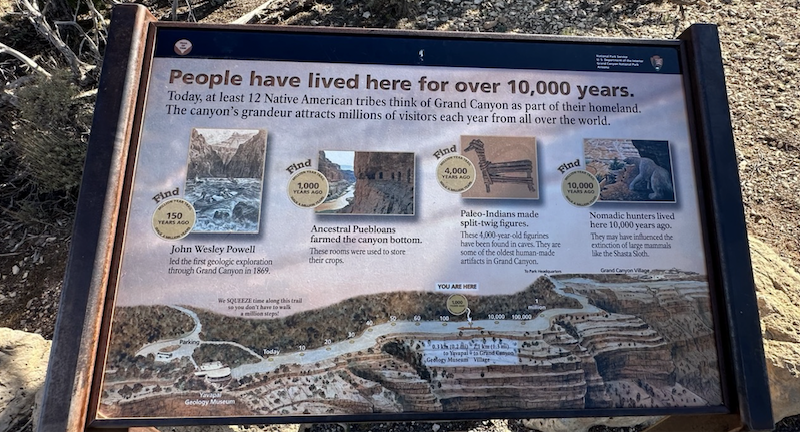







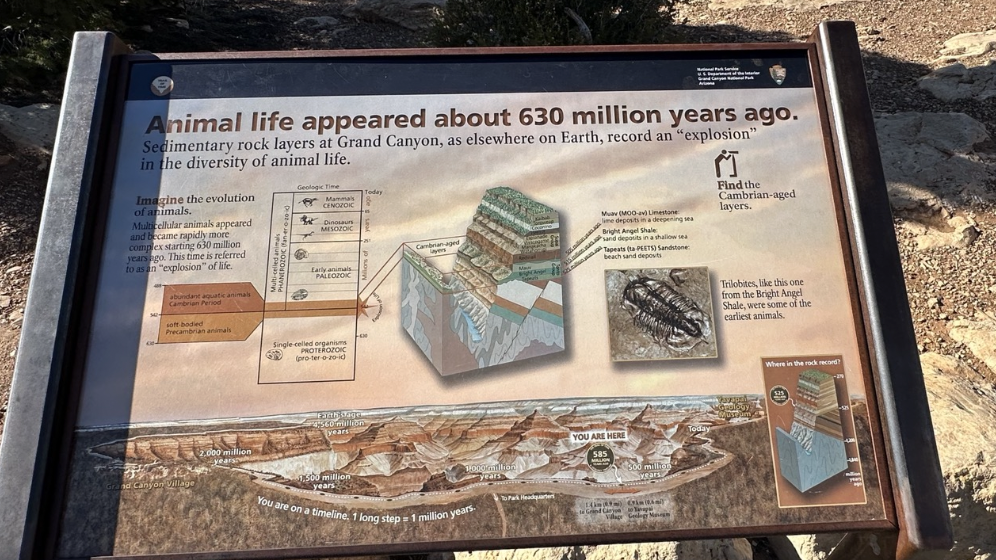


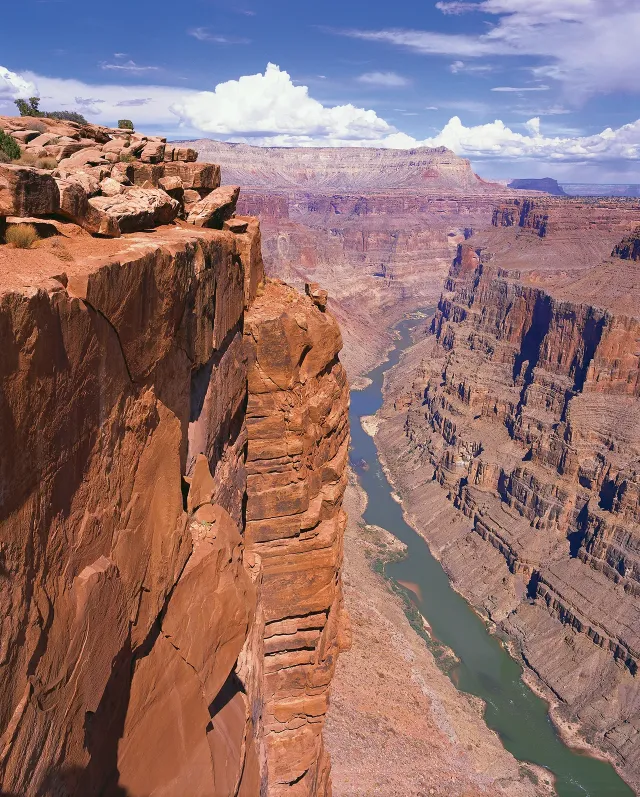
붉은 화살표 Yavapai Point에서 내려다 보는 Grand Canyon은 그야말로 장관이다. 저 겹겹이 쌓여있은 지층들을 다음 도표에서 3가지 크게 나누어 설명하고있다. Paleozoic Rocks (고생대 암석), Supergroup, Vishnu Basement Rocks.
Grand Canyon’s Three Sets of Rocks
Figure 24. Stratigraphic column of rocks of the Grand Canyon region showing the three sets of rocks and major unconformities: Great Nonconformity (white line), Great Angular Unconformity (red line) and Great Unconformity (black line). Fm = Formation; Ss = Sandstone; Ls = Limestone. 세 세트의 암석과 주요 부정합을 보여주는 그랜드 캐니언 지역 암석의 층위학적 Column: Great Nonconformity(흰색 선), Great Angular Unconformity(빨간색 선)와 Great Unconformity(검은색 선)이다. Fm = 형성; Ss = 사암; Ls = 석회암
Grand Canyon 이 지형학적으로 아주 유명한 이유는 바로 위 빨간줄로 표시된 대부정합때문이다.
대부정합(Great Unclnformity)은 층층이 쌓인 암석 간의 나이가 10억년 이상 상당한 격차를 나타내는 곳이다. 침식으로 인해 이전에 퇴적된 암석층이 제거되어 지구 역사의 증거가 지워지는 상당히 오랜 시간을 의미한다. 대부정합은 암석 기록에서 누락된 방대한 양의 지질학적 시간을 나타내기 때문에 지질학자들에게 매우 중요하다. 대부정합 아래에는 Grand Canyon 에서 발견된 가장 오래된 암석 중 일부인 선캄브리아기 암석이 있다. 이 암석은 편암, 편마암, 화강암을 포함하며 변성 및 심성 활동과 같은 다양한 과정을 통해 형성이 되었는데 그들은 약 17억년에서 5억 4천만년 전까지의 시간 범위를 나타낸다. 이는 침식 작용으로 이전에 퇴적된 지층이 제거되어 산 형성, 화산 활동, 해수면 변화와 같은 주요 지질학적 사건의 증거를 잃어버린 상당히 오랜 기간을 나타낸다. 대부정합 상부에는 고생대 퇴적암이 발견이 되는데 이 퇴적층은 약 5억 4천만년에서 2억 5천만 년 전의 고생대에 퇴적 되었다. 처음에는 선캄브리아기 암석이 퇴적된 후 융기 및 침식을 겪었고 이 침식은 지각 활동과 변화하는 환경조건으로 인해 상당한 양의 암석층이 제거되었다. 그 후 이 지역은 다시 물에 잠겼고 고생대 퇴적암이 침식된 표면 위에 퇴적되었다.
What’s Missing?
Rock layers record time. Sometimes rocks erode away, and we lose that record. Some 5,000 feet of rock has already eroded from the top of Grand Canyon, deleting the stories of the most recent 270 million years, including the time of the dinosaurs. Where Paleozoic Rocks rest directly on Basement Rocks, the contact represents a gap of 1,150 million years. Geologists call this gap the Great Unconformity. Wedges of Supergroup Rocks, where present, record some of this missing time.
무엇이 빠졌나?
암석층은 시간을 기록한다. 때때로 암석은 침식되어 그 기록을 잃게 된다. 약 5,000피트의 암석이 이미 그랜드 캐년 꼭대기에서 침식되어 공룡 시대를 포함하여 가장 최근 2억 7천만년의 역사를 삭제되었다. 고생대 암석이 기저 암석 위에 바로 놓여 있는 경우 접촉은 11억 5천만년의 간격을 나타낸다. 지질학자들은 이 격차를 대부정합(Great Unconformity)이라고 부른다. Supergroup Rocks의 쐐기(Wedges of Supergroup Rocks)가 존재하는 경우 이러한 누락된 시간의 일부를 기록한다.
Grand Canyon 만큼 지질학의 살아있는 교육은 없다고 본다. 특히, Grand Canyon Trail of Time 은 강추!
Grand Canyon Trail of Time
The Trail of Time is an interpretive walking trail that focuses on Grand Canyon's vistas and rocks, encouraging visitors to ponder, explore, and understand the magnitude of geologic time and the stories told by canyon's rock layers and landscapes. Walking the trail is intended to give park visitors a visceral appreciation for the magnitude of geologic time...This 4.56 km (2.83 mile) long trail is actually a geologic time-line. Each meter on the trail signifies one million years of Grand Canyon's geologic history; and bronze markers mark one meter intervals. Every tenth marker is labeled in millions of years. NPS Photo by Erin Whitakker. For more information: tot.unm.edu/
그랜드 캐니언 시간의 흔적
시간의 흔적(Trail of Time)은 그랜드 캐년의 경치와 암석에 초점을 맞춘 해석적 산책로로, 방문객들이 지질학적 시간의 규모와 협곡의 암석층과 풍경이 전달하는 이야기를 숙고하고, 탐험하고, 이해하도록 장려했다. 트레일을 걷는 것은 공원 방문객에게 지질학적 시간의 규모에 대한 본능적인 감사를 제공하기 위한 것이다. 이 4.56km(2.83마일) 길이의 트레일은 실제로 지질학적 연대표이다. 트레일의 각 미터는 그랜드 캐년의 지질학적 역사의 100만 년을 의미한다. 청동 마커는 1미터 간격을 표시한다. 매 10번째 마커는 수백만 년 단위로 표시된다. 더 많은 정보를 원하시면: tot.unm.edu/
History of the Trail
The concept of a scaled geologic walking trail, along the heavily-visited South Rim, was originally conceived in 1995 by Dr. Karl Karlstrom and Dr. Michael Williams as a way to improve geoscience interpretation at Grand Canyon and connect research advances to public geoscience education. In 2001 Dr. Karl Karlstrom and Dr. Laura Crossey began applying for funding from the National Science Foundation to implement the project. Major progress on the project started in 2006 when funding was obtained from the National Science Foundation Informal Science Education Program. Since then the Trail of Time has grown to include Dr. Steve Semken (at Arizona State University), Ryan Crow (at University of New Mexico), many partners at Grand Canyon National Park, professional exhibit designers at Jim Sell Designs, and professional evaluators at Selinda Research Associates, among others. Figure of proposed trail A portion of the Trail as conceived in 1995
트레일의 역사
방문객이 많은 사우스 림(South Rim)을 따라 확장된 지질학적 산책로라는 개념은 원래 1995년에 칼 칼스트롬(Karl Karlstrom) 박사와 마이클 윌리엄스(Michael Williams) 박사가 그랜드 캐년의 지구과학 해석을 개선하고 연구 발전을 공공 지구과학 교육과 연결하기 위한 방법으로 고안했다. . 2001년에 Karl Karlstrom 박사와 Laura Crossey 박사는 이 프로젝트를 구현하기 위해 국립 과학 재단에 자금 지원을 신청하기 시작했다. 프로젝트의 주요 진전은 2006년 국립과학재단 비공식 과학 교육 프로그램으로부터 자금 지원을 받으면서 시작되었다. 그 이후로 Trail of Time은 Steve Semken 박사(애리조나 주립 대학교), Ryan Crow(뉴멕시코 대학교), Grand Canyon 국립공원의 많은 파트너, Jim Sell Designs의 전문 전시 디자이너 및 전문 평가자들이 포함되었다.
'Trail of Time '에서 눈에 띄는 암석은 역시 가장 오래된 편암인 Vishnu schist 였다. 17억년전 지층이 변성된 것이라니… 지질학의 나이는 상상을 초월한다.
The Proterozoic Vishnu schist, the oldest exposed rocks of the canyon, mountain building episodes occurred 1.7 billion years ago. Grand Canyon 협곡의 가장 오래전에 노출된 암석인 원생대의 비슈주 편암은 17억년 전에 일련의 조산운동으로 만들어졌다.
2.7억년전이라… 페름기에 해당된다. 암모나이트, 산호초, 곤충들이 지구를 덮었던 시대이다. 이시기 마지막에 대멸종이 일어나면서 지구상의 95%에 달하는 생물종이 사라지게 된다.
누가 살고 있었을까? 원주민인 Pueblo, Hopi, Yavapai, Navajo Indian (위사진 차례대로) 이 거주하고 있었다.
백인들은? 1540년 이 지역을 탐사하던 스페인 코로나도 탐험대의 Lopez de Cardenas가 최초로 Grand Canyon에 들어왔다.
In 1539, Friar Marcos de Niza, a Franciscan priest, reported to Spanish colonial officials in Mexico City that he’d seen the legendary city of Cibola. Viceroy Mendoza, on January 6, 1540, appointed Francisco Vázquez de Coronado to lead an expedition to conquer the area. In February 1540, Coronado’s route, began in what is now Puerto Vallarta on the west coast of Mexico, heading north through the Sinaloa and Sonora deserts, and headed north on trails that parallels today’s border of Arizona and New Mexico. It was a medieval-looking army of 350 European men-at-arms, a large number of spouses, African slaves, and servants, and as many as 2,000 Mexican Indian allies, mostly warriors from Aztec, Tarascan, and other tribes from central and western Mexico, 540 saddle horses for the caballeros, 960 pack horses and mules, and cattle, sheep and pigs for the expedition commissary. On July 7, 1540, Coronado’s large military expedition made its way to the villages of the Cibola (the present day Zuni Reservation of west central New Mexico) where a major battle occurred between the Zunis and the Spaniards in which Coronado narrowly escaped death. It is likely that the horses and sheep with Coronado were the first the Zunis had ever seen. Juan Galeras, and a third, unnamed soldier to descend into the Canyon and report back about the river below. After descended some 1/3 of the way they were forced to return because of lack of water. In their report, they noted that some of the rocks in the Canyon were “bigger than the great tower of Seville.” Without water, the Cardenas detachment remained only three days on the Canyon rim.
1539년 프란체스코회 신부 마르코스 데 니자(Marcos de Niza) 수사는 멕시코 시티에 있는 스페인 식민 관리들에게 전설적인 도시 시볼라를 보았다고 보고했다. 1540년 1월 6일 멘도사 총독은 프란시스코 바스케스 데 코로나도를 임명하여 이 지역을 정복하기 위한 원정대를 이끌었다. 1540년 2월 코로나도의 경로는 현재 멕시코 서해안의 푸에르토 발라타에서 시작되어 시날로아와 소노라 사막을 거쳐 북쪽으로 향했고, 오늘날의 애리조나와 뉴멕시코 국경과 평행한 산책로를 따라 북쪽으로 향했다. 350명의 유럽 무장병과 다수의 배우자, 아프리카인 노예, 하인, 그리고 2,000명이나 되는 멕시코 인디언 동맹국으로 구성된 중세풍의 군대였으며 대부분은 아즈텍, 타라스칸, 기타 중부 및 중부 및 기타 부족 출신이었다. 1540년 7월 7일, 코로나도의 대규모 군사 원정대는 시볼라(현재 뉴멕시코 중서부의 주니 보호구역) 마을로 향했고, 그곳에서 주니족과 스페인족 사이에 대규모 전투가 벌어졌고 코로나도는 가까스로 죽음을 면했다. 코로나도와 함께 있는 말과 양은 주니족이 처음으로 본 것일 가능성이 높다. 카르데나스는 파블로 데 멜그로사(Pablo de Melgrossa), 후안 갈레라스(Juan Galeras), 이름이 알려지지 않은 세 번째 군인에게 협곡으로 내려가 아래 강에 대해 보고하라고 명령했다. 1/3 정도 내려간 후 물이 부족하여 어쩔 수 없이 돌아왔다. 그들은 보고에서 협곡에 있는 암석 중 일부가 “세비야의 거대한 탑보다 더 컸다”고 지적했다. 물이 없었기 때문에 카르데나스 부대는 캐년 가장자리에 3일밖에 머물지 못했다.
그는 350명의 유럽 무장병과 다수의 배우자, 아프리카인 노예, 하인, 그리고 2,000명이나 되는 멕시코 인디언 동맹국으로 구성된 중세풍의 군대를 대동했다.
실제로 Grand Canyon을 세상에 알려지게 한 인물은 1869년 존 웨슬리 포웰 (John Wesley Powell)었다. 그는 남북 전쟁때 한쪽 팔을 잃어버린 외팔이 퇴역 소령. 4대의 보트로 72일간 파월 지리학 탐험대(Powell Geographic Expedition)를 이끌고 미국 남서부의 그린강과 콜로라도강의 최초 지도제작 및 과학적 조사를 하였다.
The Powell Geographic Expedition of 1869, led by American naturalist John Wesley Powell, was the first thorough cartographic and scientific investigation of long segments of the Green and Colorado rivers in the southwestern United States, including the first recorded passage of white men through the entirety of the Grand Canyon. The expedition, which lasted approximately three months during the summer of 1869, embarked from Green River Station, Wyoming Territory and traveled downstream through parts of the present-day states of Colorado and Utah before reaching the confluence of the Colorado and Virgin rivers in present-day Arizona and Nevada . Despite a series of hardships, including losses of boats and supplies, near-drownings, and the eventual departures of several crew members, the voyage produced the first detailed descriptions of much of the previously unexplored canyon country of the Colorado Plateau.
1869년 여름 동안 약 3개월 동안 지속된 탐험은 와이오밍 준주 그린리버역에서 출발하여 현재의 콜로라도주와 유타주 일부를 거쳐 하류로 여행한 후 현재 콜로라도강과 버진강의 애리조나와 네바다 합류점에 도달했다. 보트와 보급품의 손실, 거의 익사할 뻔한 상황, 결국 여러 명의 선원이 떠나는 등 일련의 어려움에도 불구하고 항해를 통해 이전에 탐험되지 않았던 콜로라도 고원의 협곡 지역 대부분에 대한 최초의 상세한 설명이 이루어졌다.
그 이후 Grand Canyon 개발 계획을 놓고 의견이 분분하였는데, 1908년 Theodore Roosevelt (1858 - 1919) 대통령의 지시로 National Monument로 지정되었고, 1919년에 미국 의회의 승인으로 국립공원으로 승격했다. 세계 7대 자연경관중의 하나로 꼽히는 Grand Canyon. 1979년에 유네스코 세계유산으로 지정되었고, 현재는 BBC가 선정한 죽기 전에 꼭 가봐야 할 곳 1위에 선정될 정도로 유명해졌다.
해마다 500만명이 몰려들어 매년 평균 12명이 사망하고 다수가 실종된다고 한다. 이날도 저 위험한 절벽에서 인생샷을 찍겠다고 모여있는 사람들이 보인다.
According to recent reports, the Grand Canyon has seen around 14-16 deaths in 2024, which is considered near the average annual death toll for the park, typically ranging between 10-15 fatalities per year; most deaths are attributed to factors like falls, drownings, heart attacks, and natural causes.
다음 웹사이트는 현재 진행되는 지질학 연구 동영상이다. 강추!
Scientists FOUND Something DISTURBING In The Grand Canyon.. This monumental find could change our understanding of this natural wonder forever.